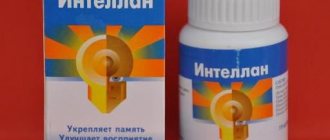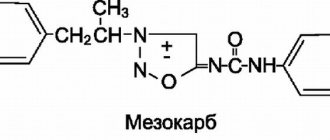Indications and contraindications for Vinpocetine therapy
The instructions contain the following recommendations for the use of the drug:
- chronic, acute circulatory failure in the brain;
- encephalopathy arising from trauma;
- vascular damage to the brain with memory impairment, cephalalgia, dizziness;
- VSD during menopause;
- decreased hearing acuity of toxic, vascular etiology;
- non-inflammatory diseases of the inner ear, etc.
Vinpocetine is contraindicated in patients:
- after acute hemorrhagic stroke;
- with ischemic heart disease, arrhythmia;
- intolerance to the component composition;
- underage.
During therapeutic procedures, Vinpocetine in some cases provokes adverse reactions. The main symptoms are presented:
- increased heart rate, unstable blood pressure;
- changes in ECG, hot flashes;
- extraordinary contractions of the heart muscle;
- attacks of cephalgia with dizziness, insomnia;
- heartburn, nausea, dry oral mucosa;
- allergies with redness, obsessive itching, dermatological rash.
Side effects of the drug are determined by the active work of the sweat glands and a state of general weakness. The occurrence of unusual symptoms requires visiting a doctor and changing the drug.
Vinpocetine
The drug vinpocetine belongs to the group of correctors of cerebral circulatory disorders. The drug has a vasodilating, antiaggregation, antihypoxic effect, and improves cerebral circulation. It is used mainly for insufficient blood supply to areas of the brain, as well as for vascular diseases of the retina and choroid (the morphological similarity of the blood vessels of the brain and eye makes it possible to use vinpocetine in both cases).
Vinpocetine blocks the action of the phosphodiesterase enzyme, as a result of which the concentration of cyclic adenosine monophosphate in the cells increases, which, in turn, entails a decrease in the content of calcium ions in the cytoplasm of smooth muscle cells and relaxation of muscle fibers. Vinpocetine combines both vascular and metabolic effects. The first is supported by the drug’s ability to increase the lumen of blood vessels in the brain, stimulate blood flow primarily in ischemic areas and solve “supply” problems by improving the mechanisms of oxygen delivery to the brain. The role of vinpocetine in metabolic processes is no less important: it promotes the utilization of glucose, increases the concentration of catecholamines in the central nervous system, and “ignites” the metabolism of the neurotransmitters norepinephrine and serotonin in brain tissue. Affects the quality characteristics of blood: reduces platelet aggregation, reduces blood viscosity, increases the degree of deformability of red blood cells, due to a decrease in vascular resistance, normalizes the outflow of venous blood, slightly reduces blood pressure.
Vinpocetine is very good for acute stroke: it promotes the shortest relief of neurological symptoms, sharpens attention, improves memory, and restores intellectual functions. Elderly patients are particularly sensitive to the relaxing effect of the drug. This is due to the increasing role of the adenylate cyclase system, which is a natural consequence of the aging process.
Vinpocetine is quickly and completely absorbed from the digestive tract. Its maximum concentration in the blood is reached 1 hour after administration. Available in two dosage forms: tablets and solution for intravenous administration. There is also a concentrate for preparing a solution for infusion, but the popularity of this formulation does not extend beyond hospitals. Tablets are taken orally after meals, 5-10 mg 3 times a day. After the so-called During the “loading” period, vinpocetine is taken in a maintenance dose: 5 mg 3 times a day. The duration of treatment is 60 days. The injection solution of the drug is administered intravenously, by drip. The therapeutic course is 1.5 - 2 weeks, after which the patient is transferred to the tablet form - 10 mg 3 times a day - with a gradual reduction in dosage before completely discontinuing the drug.
Methods of therapy and dosage from the instructions for Vinpocetine
Tablets for oral administration are prescribed at 5-10 mg, up to 3 times a day. The therapeutic regimen depends on the type of current disease and the severity of the clinical picture.
In an injection solution, the drug is administered intravenously, the maximum single dose does not exceed 20 mg. Injections are used in acute conditions; if therapy in the first days did not cause unusual reactions in the body, then the initial volume is increased for 3-4 days to 1 mg per kilogram of weight. The duration of treatment is 2 weeks.
Accidental increase in the dosage recommended by the instructions provokes the appearance of side effects in the form of allergies, heart rhythm disturbances, sleep problems, headaches and dizziness. To suppress clinical manifestations, the patient's stomach is washed and one of the available sorbents is given: Smecta, activated carbon (1 tablet for every 10 kg of weight). Subsequently, symptomatic therapy is carried out.
Over the past decades, there has been a steady increase in the number of patients with sensorineural hearing loss (SNHL), leading to a decrease in the quality of life, disruption of social and work adaptation. According to official data, in Russia NST is observed on average by 15 people per 10 thousand population. The clinical picture of NTS is characterized by hearing loss and the appearance of tinnitus; in severe cases, dizziness and coordination disorders appear. The etiology of NST is varied. These are various infectious diseases caused by viruses or bacteria, intoxication with chemical or ototoxic substances, including medications, various injuries (mechanical, barotrauma, acoustic and vibration), age-related vascular disorders. Changes in weather, including fluctuations in air pressure, can also cause NTS. According to the timing of development, sudden NTS is distinguished (up to 12 hours from the onset of onset), acute (up to 1 month), subacute (from 1 to 3 months) and chronic (over 3 months) [1-4].
Patients with NTS, as a rule, turn to both an otolaryngologist and a neurologist. The otorhinolaryngologist conducts an examination and audiometric examination. A neurologist, in addition to examination, usually recommends ultrasound examination of trans- and extracranial vessels and MRI of the brain. However, this is often not enough for a correct diagnosis. A comprehensive examination of an otoneurologist is preferable; it is not easy to get a consultation with him. In this regard, in practice, the issue is resolved in this way - if the cause of NST is infectious diseases (ARVI, herpes, infectious parotitis), ear injury, ototoxic effects of chemicals or drugs (aminoglycoside antibiotics, salicylates), then the patient is treated by an otolaryngologist. With NCT of vascular origin, developed against the background of hypertension, cerebral atherosclerosis, pathology of the cervical spine, which, according to clinical studies, occur in more than half of the cases - in a neurologist [1-4].
Regardless of the etiology, with NST, dyscirculatory changes in hemodynamics are detected, which lead to the development of ischemia, hypoxia, metabolic disorders and trophism of the receptors of the ear labyrinth or the nuclei and pathways of the auditory analyzer in the brain. Therefore, treatment should be aimed at stabilizing cell membranes, dehydration, improving blood rheology, increasing venous outflow from the cranial cavity, and improving blood circulation in the inner ear. Complex therapy of NST, depending on the etiology, includes antibacterial, dehydration, vascular, hormonal, sedative and vascular therapy. Vestibulolytics (betagistine hydrochloride) and B vitamins are also effective [1-5].
As studies conducted in recent years have shown, one of the effective drugs with complex action, which improves microcirculation in the inner ear and metabolism of brain tissue, and also activates regenerative and antioxidant mechanisms, is Cavinton. In recent years, the effectiveness of Cavinton has been proven in 7 double-blind placebo-controlled studies, in a meta-analysis that included data on 731 patients, in open comparative long-term (10 years of use) studies that included 967 patients, in a long-term double-blind placebo-controlled randomized study on a large number of patients (more than 8000) [6, 7].
In Russia, in 2010, within the framework of the CALIPSO program, a multicenter clinical and epidemiological study was conducted to assess the effectiveness and safety of therapy with new forms of Cavinton and Cavinton Forte. We examined 4865 patients aged 31 to 85 years with chronic cerebral ischemia, who, along with other symptoms, had tinnitus, dizziness, and coordination problems. Currently available data indicate that the therapeutic effect of Cavinton depends on the dose and route of administration, so a new regimen for prescribing Cavinton has been proposed. It is recommended to begin therapy with Cavinton by infusion drip at a dose of 25-50 mg diluted in 400 ml of saline for 7 days, followed by switching to oral administration of Cavinton Forte 10 mg 3 times a day for 90 days. The new regimen for prescribing Cavinton led to a statistically significant reduction in tinnitus in 46% of patients included in the study, dizziness in 75%, and coordination disorders in 52% (Fig. 1, [8]).
Figure 1. Dynamics of regression of complaints from patients with chronic cerebral ischemia during therapy with Cavinton and Cavinton Forte (CALIPSO program).
It was found that Cavinton improves brain metabolism, increases the resistance of brain cells to hypoxia, inhibits platelet aggregation, reduces pathologically increased blood viscosity, and has an antioxidant effect. It has been proven that the drug does not affect systemic hemodynamics, does not change the electrical activity of the heart and does not have arrhythmogenic activity. By improving blood supply to the affected area, the drug does not cause the “stealing” phenomenon. The drug is well tolerated by elderly patients with liver and kidney failure and does not require dose adjustments. It is recommended to administer Cavinton slowly by infusion drip at a rate of up to 80 drops per minute. Based on the results obtained, it was concluded that the drug Cavinton has a complex mechanism of action. Numerous studies have established that the drug has a beneficial effect not only on cerebral circulation, cerebral metabolism and rheological properties of blood, but also on microcirculation in the inner ear, which allows us to consider the drug Cavinton and Cavinton Forte as the drug of choice for NST [8].
The effectiveness of the new Cavinton regimen was confirmed by the results of an open randomized comparative Russian study in the treatment of chronic sensorineural hearing loss of vascular origin.
The purpose of the study was to evaluate the effectiveness and tolerability of the new Cavinton regimen in the treatment of patients with NCT.
Patients and methods
We examined 50 patients aged from 30 to 65 years, suffering from 1 to 22 years of stage II-III vascular NCT. The patients were divided into 2 groups of 25 people. The course of treatment in group 1 began with intravenous infusion of Cavinton according to a gradually increasing scheme over 7 days from 20 mg to 50 mg in 500 ml of saline. After this, the patients took Cavinton Forte 10 mg 3 times a day for 11 weeks. A control group of 25 people received traditional treatment, including vitamins, physical therapy, hyperbaric oxygenation, and parameatal novocaine blockades. The evaluation of treatment results was carried out over time, taking into account complaints, audiological examination, tuning fork examination and the results of Doppler ultrasound of the carotid and vertebral arteries in the initial state and when turning the head. Tinnitus change was assessed using a visual analogue scale.
Results and discussion
In 20 (80%) patients receiving Cavinton, there was a significant improvement in hearing and a decrease in tinnitus. In the control group receiving traditional therapy, a positive result was observed in only 11 (44%) people. Moreover, in the group receiving Cavinton, a positive result was obtained much earlier compared to the control group (Fig. 2).
Figure 2. Dynamics of positive changes in the audiological picture in patients with sensorineural hearing loss. Based on previously obtained data, it was concluded that high doses of Cavinton are more effective in the treatment of patients with NTS [9].
Thus, the new Cavinton regimen can be recommended for the treatment of sensorineural hearing loss in both young and elderly people. In the chronic form of NST, repeated courses of Cavinton and Cavinton Forte 2-3 times a year are advisable.








